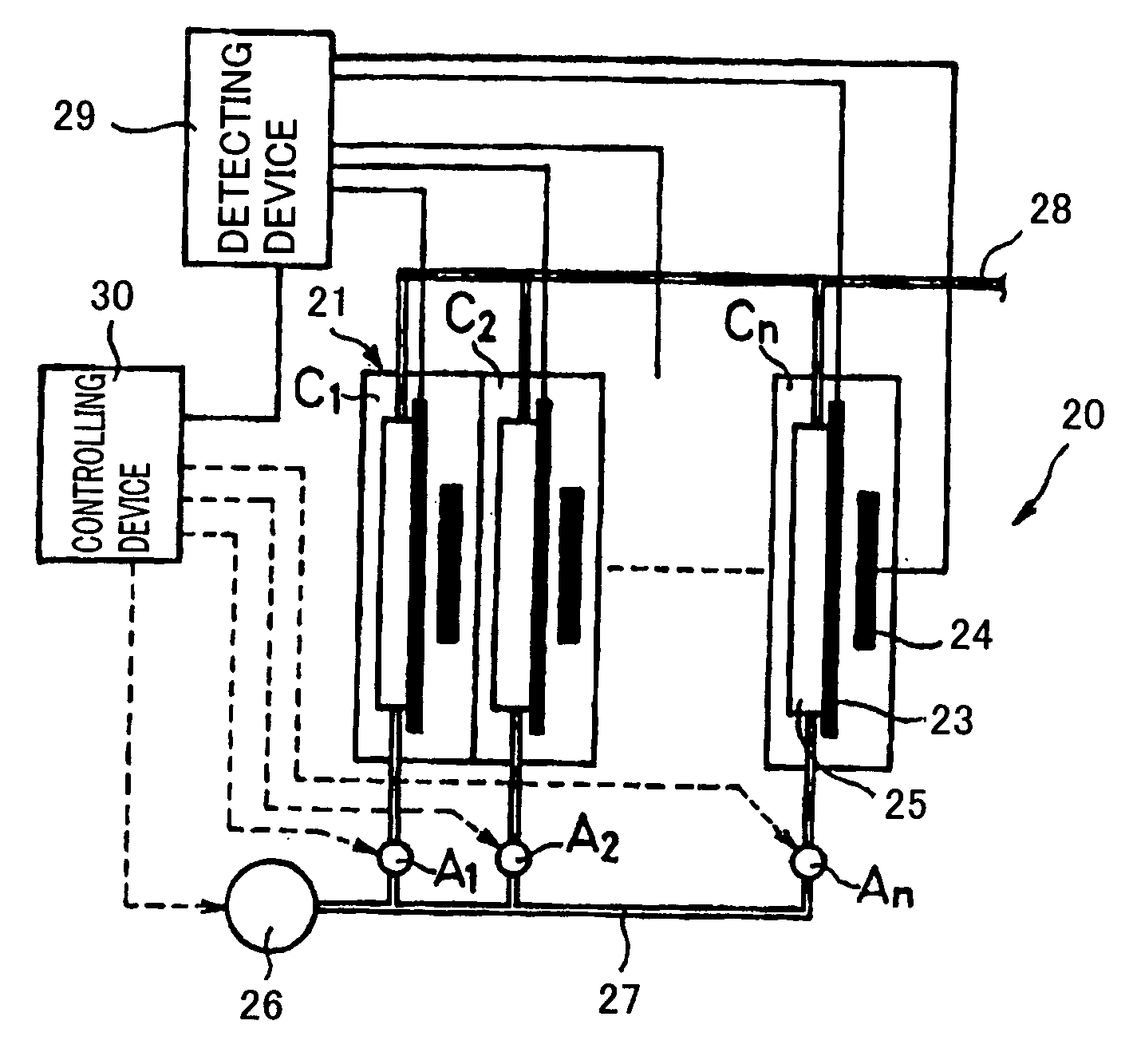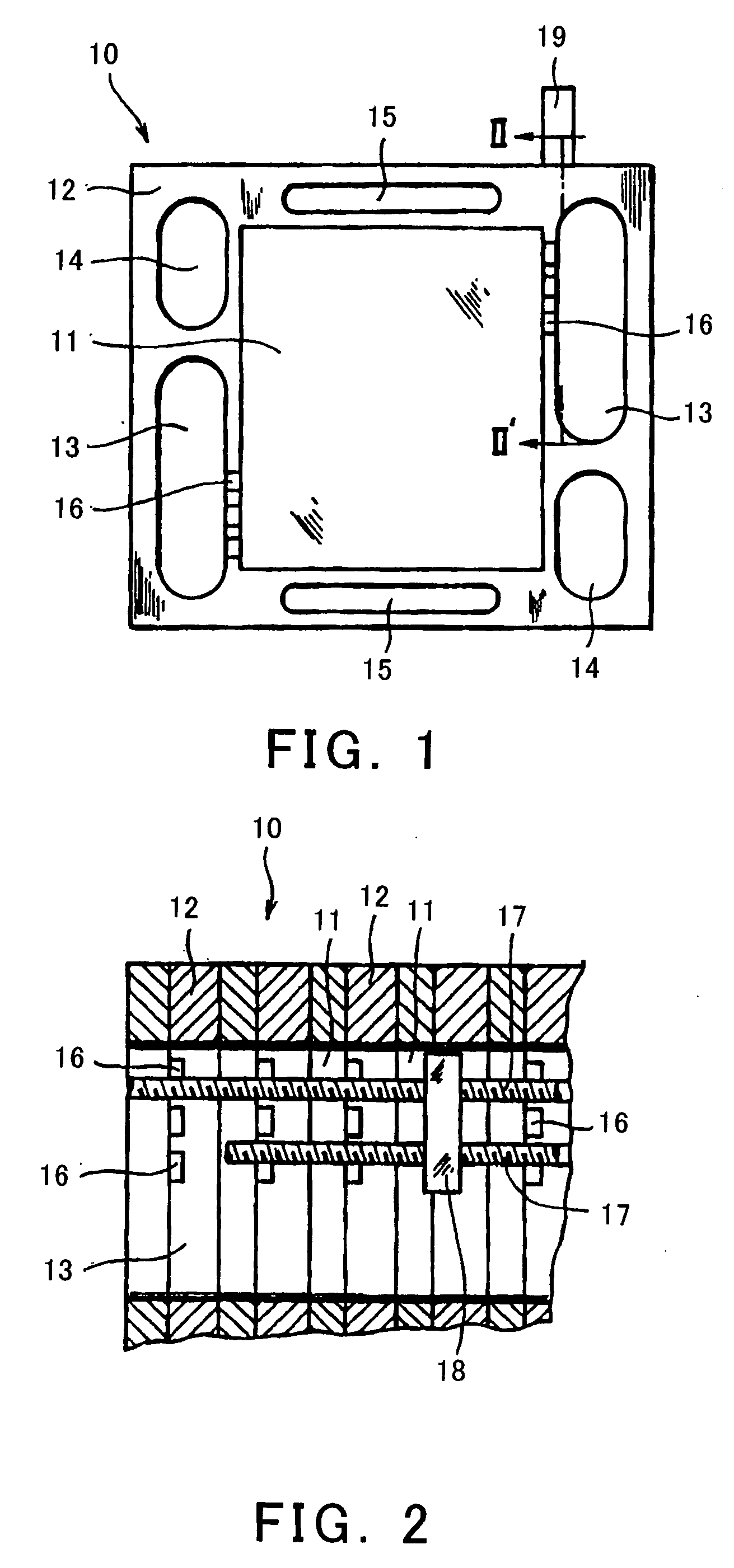Method of operation fuel cell system and fuel cell system
a fuel cell and fuel cell technology, applied in the direction of cell components, electrochemical generators, cell component details, etc., can solve the problems of consuming labor and cost for exchanging filters, unable to restore voltage once lowered, and eventually lowering the generated voltage of the voltag
- Summary
- Abstract
- Description
- Claims
- Application Information
AI Technical Summary
Benefits of technology
Problems solved by technology
Method used
Image
Examples
embodiment 1
[0136] FIG. 6 is a block diagram to show one example of the construction of a fuel cell system according to Embodiment 1 of the invention. In FIG. 6, 301a stands for a fuel cell stack. This fuel cell stack 301a is constituted of stacked plural cells 31a, 31a . . . . The respective cells 31a are provided with a pair of electrodes, i.e., an anode 32a and a cathode 33a, and are connected in series.
[0137] Incidentally, the construction of the fuel cell stack 301a is the same as a usual polyelectrolyte type fuel cell stack. Accordingly, a polyelectrolyte membrane is disposed between the anode 32a and the cathode 33a. Also, the anode 32a and the cathode 33a are each comprised of a gas diffusion layer and a catalyst layer, and the catalyst layer has a Pt catalyst.
[0138] The fuel cell stack 301a is connected to a load 306a and a cell voltage detection unit 304a for detecting the voltage of each cell 31a. Also, the fuel cell stack 301a is connected to an external electric source 307a for con...
example 2
Embodiment 2
[0160] In the fuel cell system according to Embodiment 2 of the invention, after stopping of the load, feeding of the oxidizing agent gas and feeding of the fuel gas are carried out approximately simultaneously, thereby avoiding degradation of the fuel cell.
[0161] FIG. 9 is a block diagram to show one example of the construction of a fuel cell system according to Embodiment 2 of the invention. In FIG. 9, 301b stands for a fuel cell stack. This fuel cell stack 301b is constituted of stacked plural cells 31b, 31b . . . . The respective cells 31b are provided with a pair of electrodes, i.e., an anode 32b and a cathode 33b, and are connected in series.
[0162] Incidentally, the construction of the fuel cell stack 301b is the same as a usual polyelectrolyte type fuel cell stack. Accordingly, a polyelectrolyte membrane is disposed between the anode 32b and the cathode 33b of each cell 31b. Also, the anode 32b and the cathode 33b are each comprised of a gas diffusion layer and a ...
example 3
Embodiment 3
[0182] In the fuel cell system according to Embodiment 3 of the invention, after stopping of the load, feeding of the fuel gas is carried out for a longer period of time as compared with feeding of the oxidizing agent gas, thereby avoiding degradation of the fuel cell.
[0183] Incidentally, since the construction of the fuel cell system of this embodiment is the same as in the case of Embodiment 2, its explanation is omitted. In the case where the fuel cell stack 301b of the fuel cell system of this embodiment stops power generation, the timing of stopping feeding of the oxidizing agent gas and the fuel gas will be described below while referring to FIG. 9.
[0184] FIG. 11 is a timing chart to show the operations of the fuel cell system according to Embodiment 3 of the invention in the case where the fuel cell stack 301b stops power generation. In FIG. 11, FIGS. 11A to 11F correspond to FIGS. 10A to 10F in FIG. 10.
[0185] As shown in FIG. 11A, in this embodiment, the control ...
PUM
| Property | Measurement | Unit |
|---|---|---|
| voltage | aaaaa | aaaaa |
| voltage | aaaaa | aaaaa |
| threshold temperature | aaaaa | aaaaa |
Abstract
Description
Claims
Application Information
 Login to View More
Login to View More - R&D
- Intellectual Property
- Life Sciences
- Materials
- Tech Scout
- Unparalleled Data Quality
- Higher Quality Content
- 60% Fewer Hallucinations
Browse by: Latest US Patents, China's latest patents, Technical Efficacy Thesaurus, Application Domain, Technology Topic, Popular Technical Reports.
© 2025 PatSnap. All rights reserved.Legal|Privacy policy|Modern Slavery Act Transparency Statement|Sitemap|About US| Contact US: help@patsnap.com



